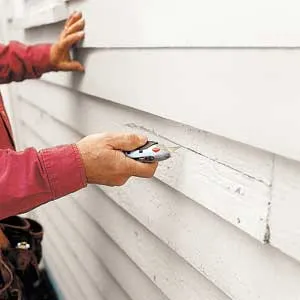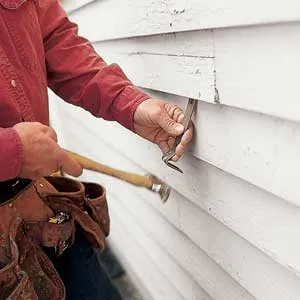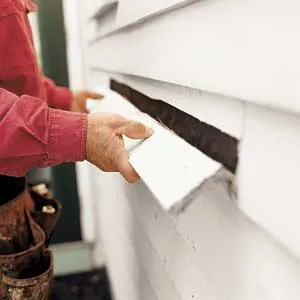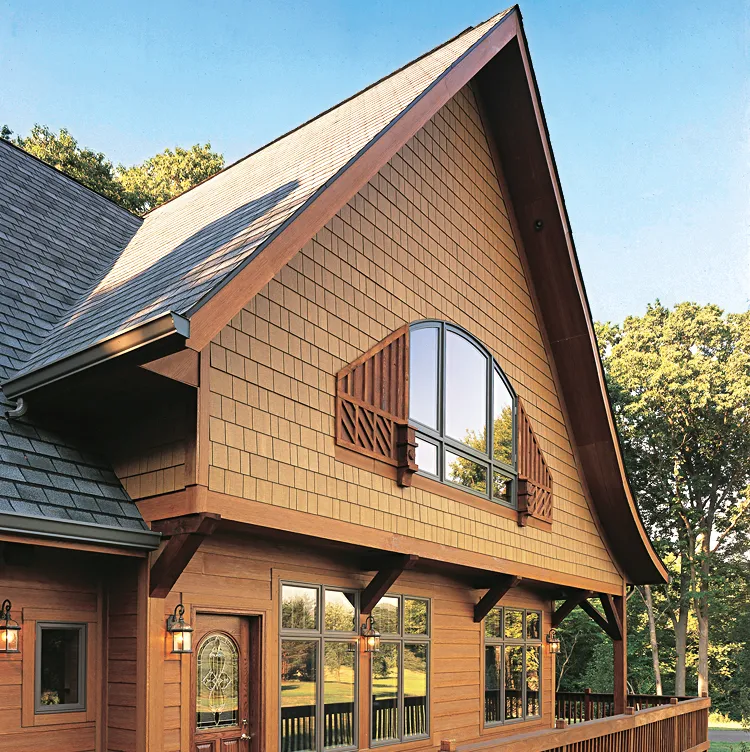Whether it’s cracked, rotted, or the victim of a woodpecker’s beak, a damaged strip of wood siding is an open invitation for water to leak into a home and wreak havoc. If you have clapboard wood siding and a piece needs fixing, it’s a task that merits a top spot on your to-do list.
Advice From a Pro
It’s can be quite simple to replace a broken clapboard, but as This Old House general contractor Tom Silva emphasizes, it’s a delicate process that takes patience and precision. You’ll need to swap out your power tools for hand tools, since vibration can break the surrounding clapboards. “Then,” says Silva, “you’ll end up installing much more new siding than you intended.”
Steps for Repairing Wood Siding
Repairing wood siding requires patience, precision, and the right tools. Follow these steps to effectively patch your wood siding and maintain your home’s exterior integrity.
Step 1: Cut

Begin the repair process by carefully cutting the damaged section of siding. If you can manage it, try not to damage the old clapboard. You can use it later to size the replacement instead of using a tape measure.
- Use a sharp utility knife to score the entire length of the damaged clapboard from end to end, approximately halfway up from its bottom (butt) edge.
- Don’t slice all the way through the board, or you may cut the builder’s felt underneath.
- For precise cutting, consider using a straightedge as a guide to ensure a clean, straight line.
- If the damage is extensive, you may need to score multiple lines to remove the affected area completely.
Step 2: Pry

Once you’ve scored the damaged section, it’s time to remove the lower half of the clapboard.
- Just as with the last step, work slowly and carefully to minimize the risk of cracking and splitting.
- Start at one end of the scored line. Gently insert a small pry bar underneath the butt edge and next to a nail.
- Pull the bar toward you. Pushing it may mar the adjoining clapboards.
Step 3: Snap

After prying the lower half loose, you can now remove it completely.
- Keep working the pry bar along the butt edge until the lower half breaks off, ideally in one piece.
- If the removed piece is still intact, set it aside to use as a template for sizing the replacement clapboard.
- Leave the upper piece of the damaged clapboard in place for now. It’ll help guide the installation of the new piece.
- Thump the exposed sheathing to see if it’s sound. If you find soft spots or visible water damage, cut out and patch those areas before you continue.
Choosing Nails and Siding
The new clapboard should blend in seamlessly with your existing siding. Consider these factors to make sure your patch blends seamlessly:
- Sizing: Measure the butt-edge thickness and the widths of the exposed faces of several courses on the wall. Add an inch to the face width to account for the overlap of the piece above. Remember that actual dimensions may be slightly smaller than sizes listed by suppliers. If you’re unsure what size you need, ask a pro at a local hardware store to translate the measurements.
- Texture: Match the texture of your existing siding, whether it’s smooth or rough-faced. Rustic, rough-faced clapboard will stand out if the other siding is smooth.
- Grade: Silva prefers C-VG grade siding that’s knot-free and quartersawn. It’s a little more expensive but has better paint adhesion and stability. But if C-VG doesn’t match the rest of the siding, go with a grade that does.
- Color and species: The patch should be made from the same type of wood as your existing siding. If the old clapboard was painted, take a sample to your paint store and try to match the color as closely as you can.
What Nail Is Best?
Choosing the right nails is just as important as selecting the proper siding material. For siding, that choice is always stainless steel ring-shank nails. Stainless doesn’t rust, stain the paint, or leave unsightly black streaks on the wood. If you can’t find stainless steel, galvanized nails also work, but know that they might not resist corrosion as well.
For the best guarantee against pop-out, use 7d or 8d nails and drive them into the studs. The rings on the shank act like barbs, gripping the sides of the hole to keep everything in place. You can get away with pounding 5d nails just into the sheathing so long as it’s 5/8 inch or thicker and made of plywood, OSB, or solid wood.
To find out how thick your sheathing is, remove a piece of siding and poke a drill bit into a vertical seam between two sheathing pieces. These seams always land at a stud, so measuring how far the bit goes in will tell you the sheathing’s thickness.
Installing the Replacement Siding
Once you’ve removed the damaged clapboard and have your supplies, it’s time to install the replacement siding by following these steps:
- If you or your retailer haven’t already cut the replacement piece to size, do so now with a handsaw or circular saw. Use the removed section as your guide.
- For a secure seal, apply a bead of exterior-grade caulk along the top edge of the piece below where the new siding will go. This stops water from seeping in behind the siding.
- Position the new clapboard so it aligns properly with the surrounding siding.
- Nail the replacement piece in place, starting at one end and working your way across.
- Countersink the nail heads slightly and fill the areas with exterior wood filler.
- Once the filler is dry, sand the repaired area smooth.
- Prime and paint the new siding to match the existing exterior.
Maintaining Wood Siding
To prevent future damage and extend your new clapboard’s life span, follow these maintenance tips:
- Ensure your gutters and downspouts are functioning properly to direct water away from the siding.
- Clean your siding at least once per year using a soft-bristled brush and mild detergent. Pay close attention for signs of damage like cracks, rot, and pest infestations.
- Repaint or restain your siding every 5–7 years, or as needed based on your climate and exposure.
- Trim back any vegetation that comes in contact with your siding to reduce moisture retention.

